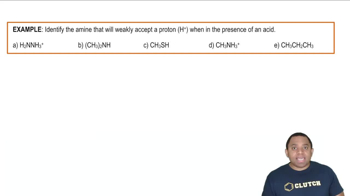In each reaction, identify the Brønsted–Lowry acid, the Brønsted–Lowry base, the conjugate acid, and the conjugate base. a. H2CO3(aq) + H2O(l) ⇌ H3O+(aq) + HCO3–(aq) c. HNO3(aq) + H2O(l) → H3O+(aq) + NO3–(aq)
Ch.17 - Acids and Bases
Chapter 17, Problem 33c
Identify each substance as an acid or a base and write a chemical equation showing how it is an acid or a base according to the Arrhenius definition. c. KOH(aq)

Verified Solution
Video duration:
1mWas this helpful?
Key Concepts
Here are the essential concepts you must grasp in order to answer the question correctly.
Arrhenius Definition of Acids and Bases
The Arrhenius definition states that acids are substances that increase the concentration of hydrogen ions (H⁺) in aqueous solution, while bases increase the concentration of hydroxide ions (OH⁻). This definition is fundamental for classifying substances based on their behavior in water.
Recommended video:
Guided course

Arrhenius Acids and Bases
Chemical Equations
Chemical equations represent the transformation of reactants into products, showing the reactants' identities and their quantities. In the context of acids and bases, these equations illustrate how an acid donates H⁺ ions or how a base provides OH⁻ ions in solution, which is essential for demonstrating their properties.
Recommended video:
Guided course

Balancing Chemical Equations
KOH as a Base
Potassium hydroxide (KOH) is classified as a strong base according to the Arrhenius definition because it dissociates completely in water to produce K⁺ and OH⁻ ions. The chemical equation for this dissociation is KOH(aq) → K⁺(aq) + OH⁻(aq), highlighting its role in increasing hydroxide ion concentration in solution.
Recommended video:
Guided course

Base Example
Related Practice
Textbook Question
339
views
Textbook Question
Identify the Lewis acid and Lewis base from among the reactants in each equation. b. AlBr3 + NH3 ⇌ H3NAlBr3 c. F–(aq) + BF3(aq) ⇌ BF4–(aq)
442
views
Textbook Question
Calculate [H3O+] and [OH–] for each solution at 25 °C. b. pH = 11.23 c. pH = 2.87
646
views
Textbook Question
In each reaction, identify the Brønsted–Lowry acid, the Brønsted–Lowry base, the conjugate acid, and the conjugate base. b. NH3(aq) + H2O(l) ⇌ NH4+(aq) + OH–(aq)
917
views
Textbook Question
In each reaction, identify the Brønsted–Lowry acid, the Brønsted–Lowry base, the conjugate acid, and the conjugate base. d. C5H5N(aq) + H2O(l) ⇌ C5H5NH+(aq) + OH–(aq)
833
views
1
rank
Textbook Question
In each reaction, identify the Brønsted–Lowry acid, the Brønsted–Lowry base, the conjugate acid, and the conjugate base. b. CH3NH2(aq) + H2O(l) ⇌ CH3NH3+(aq) + OH–(aq)
459
views
